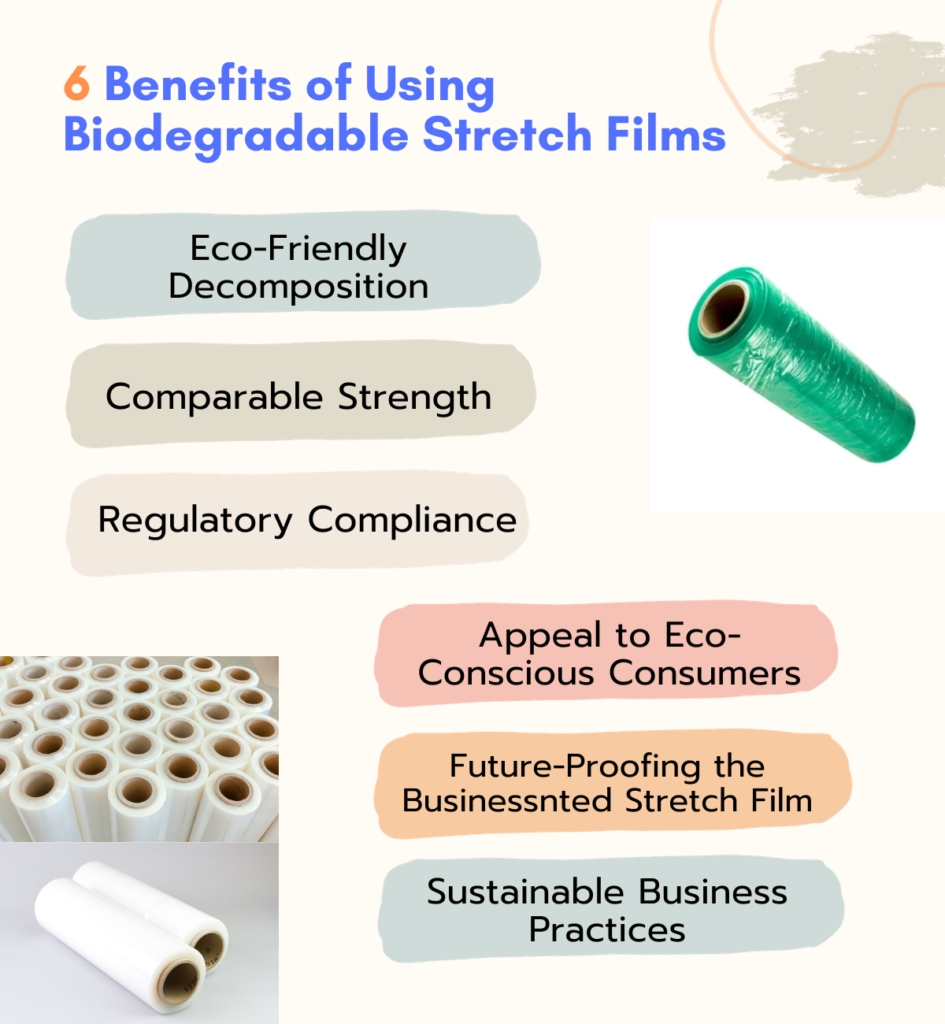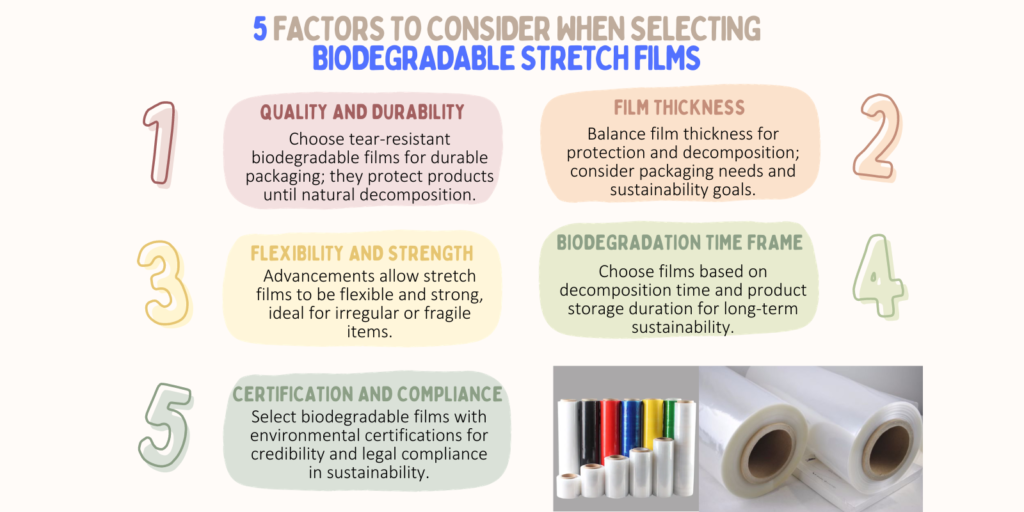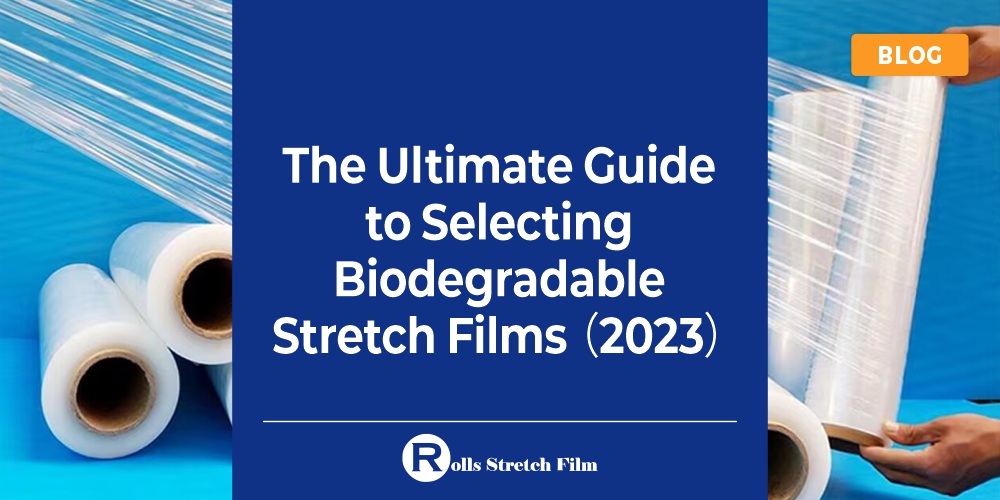Have you ever wondered how to make your packaging more eco-friendly without compromising on quality? The problem many businesses face today is balancing sustainability with efficiency. Traditional stretch films may be influential but contribute to environmental waste, posing a dilemma for conscious companies.
The answer lies in biodegradable stretch films. These films offer the same strength and reliability as traditional options but break down naturally over time, reducing your carbon footprint. You’re about to discover why biodegradable stretch films are the future of packaging and how to select the best options for your business needs. Trust us; you’ll want to read on to make your packaging process as green as it is effective.
The Need for Biodegradable Stretch Films

Environmental Impact of Non-Biodegradable Plastic Stretch Films
In my years of working closely with packaging solutions, I’ve seen firsthand the massive waste generated by non-biodegradable plastic stretch films. These traditional films may be cost-effective and efficient, but they come at a significant environmental cost. Once discarded, they can take hundreds of years to decompose, leading to landfill overflow and ocean pollution. The microplastics that eventually break off from these films enter our waterways and food chains, causing harm to aquatic life and, indirectly, humans.
6 Benefits of Using Biodegradable Stretch Films Over Traditional Plastic Films
- Eco-Friendly Decomposition: Biodegradable films naturally break down within a few months to a year, depending on environmental conditions. This rapid decomposition significantly reduces the environmental impact of packaging.
- Comparable Strength: These films offer the same tensile strength and load stability as traditional plastic films, ensuring no compromise on packaging quality.
- Regulatory Compliance: Using biodegradable films helps businesses adhere to tightening environmental regulations, ensuring they remain compliant and avoid potential penalties.
- Appeal to Eco-Conscious Consumers: With a rising number of consumers prioritizing eco-friendly products, switching to biodegradable films can enhance a company’s market appeal.
- Future-Proofing the Business: The packaging industry is evolving rapidly. Adopting biodegradable films is a proactive step that aligns with both consumer demand and environmental responsibility.
- Sustainable Business Practices: Companies can maintain their packaging efficiency while actively contributing to a greener future.

Understanding Biodegradable Stretch Films
What Biodegradable Stretch Films Are
Biodegradable stretch films are a revolutionary development in the packaging industry. Made from organic materials like cornstarch or sugarcane, these films are designed to decompose naturally over time. Unlike traditional plastic films, which are petroleum-based, biodegradable films are derived from renewable resources. Having worked with both types of films, I can attest to the efficacy of biodegradable options in fulfilling the same roles as traditional films—securing products for shipping or storage—while being environmentally responsible.
How Biodegradable Stretch Films Work

The science behind biodegradable stretch films is fascinating. These films contain microbial additives that attract bacteria and fungi once the film is exposed to specific environmental conditions like moisture and heat. These microorganisms break down the film into natural substances like water, carbon dioxide, and biomass. This process is not only efficient but also leaves no toxic residues behind. I’ve seen this technology in action and can vouch for its effectiveness in reducing waste and environmental impact.
Key Features to Look for in Biodegradable Stretch Films
When selecting biodegradable stretch films, there are several key features to consider:
- Tensile Strength: Like traditional films, the biodegradable option should offer high tensile strength for secure packaging.
- Clarity: A transparent film is often preferable as it allows for easy inspection of the packaged goods.
- Sealability: Ensure the film can be easily sealed manually or using a machine.
- Decomposition Time: Check the time it takes for the film to decompose fully. This should align with your company’s sustainability goals.
- Certifications: Look for films certified as biodegradable by reputable organizations.
5 Factors to Selecting Biodegradable Stretch Films
1. Quality and Durability
When it comes to packaging, quality and durability are non-negotiable. I’ve worked with various types of films and can confirm that not all biodegradable options are equal. Look for tear-resistant films that can withstand the rigors of shipping and handling. A high-quality film will secure your products and maintain their integrity until they naturally decomposes.
2. Film Thickness
The thickness of the film is another crucial factor. Thicker films offer more protection but may take longer to decompose. On the other hand, thinner films may be less protective but deteriorate more quickly. It’s essential to strike a balance based on your specific needs. I’ve helped companies navigate this delicate balance, and the key is to consider both your packaging requirements and sustainability goals.
3. Flexibility and Strength
Flexibility and strength are often at odds when it comes to stretch films. However, advancements in material science have made it possible to have both. A flexible yet strong film will adapt to the shape of your product while maintaining its hold. This is particularly important for irregularly shaped or fragile items.
4. Biodegradation Time Frame
Another factor to consider is the time it takes for the film to decompose. Some films break down in months, while others may take up to a year. Your choice should align with how long the packaged products will be stored or shipped. Having overseen the lifecycle of various packaging materials, I can say that understanding this aspect is crucial for long-term sustainability.
5. Certification and Compliance with Environmental Standards
Lastly, ensure that the biodegradable stretch film you choose complies with environmental standards. Look for certifications from reputable organizations that validate the film’s biodegradability and ecological impact. This not only safeguards your company against potential legal issues but also adds a layer of credibility to your sustainability efforts.

Best Biodegradable Stretch Films in 2023
Presentation of Top Biodegradable Stretch Films Available in the Market
As someone deeply involved in the packaging industry, I’ve had the opportunity to test and review various biodegradable stretch films. Based on performance, quality, and environmental impact, here are some of the top biodegradable stretch films to consider in 2023:
EcoWrap
Known for its high tensile strength and quick decomposition time.
- Specifications: 20-micron thickness, 6-month decomposition time
- Pros: High tensile strength, quick decomposition
- Cons: Slightly more expensive than competitors
GreenSeal
Offers excellent clarity and is perfect for businesses that require visual inspections of packaged goods.
- Specifications: 18-micron thickness, 9-month decomposition time
- Pros: Excellent clarity, moderate decomposition time
- Cons: Lower tensile strength
BioStretch
A versatile option that is both strong and flexible, suitable for a wide range of packaging needs.
- Specifications: 22-micron thickness, 12-month decomposition time
- Pros: High flexibility, suitable for various packaging needs
- Cons: Longer decomposition time
Where and How to Purchase These Products
When it comes to purchasing biodegradable stretch films, it’s essential to buy from reputable suppliers. Look for vendors who provide detailed product specifications and have transparent sustainability practices. Many suppliers offer bulk discounts, so consider your volume needs when making a purchase. Online platforms are a convenient option, but make sure to read customer reviews and possibly request samples before making a large order.
How to Properly Use and Dispose of Biodegradable Stretch Films
Step-by-Step Guide on How to Use Biodegradable Stretch Films
Using biodegradable stretch films is quite similar to using traditional films, but there are some nuances to consider for optimal performance. Here’s a simple guide based on my hands-on experience with these materials:
- Preparation: Ensure the items to be wrapped are clean and dry.
- Film Placement: Position the film roll on the dispenser, making sure it unrolls smoothly.
- Initial Wrap: Start by wrapping the film around the corner of the item or pallet, securing the film’s end.
- Stretch and Wrap: Stretch the film as you go, ensuring it adheres well to the item. Make sure to overlap layers for added strength.
- Final Seal: Once wrapped, cut the film and press the end firmly against the package to seal it.

Proper Methods for Disposal to Ensure Biodegradability
Proper disposal is crucial to ensure that the biodegradable stretch films live up to their eco-friendly promise. Here are some tips:
- Separate Collection: Collect used biodegradable stretch films separately from other waste to prevent contamination.
- Composting: If possible, send the films to industrial composting facilities where they can decompose under controlled conditions.
- Local Recycling Programs: Some localities have special recycling programs for biodegradable plastics. Check if such options are available in your area.
Common Mistakes to Avoid
- Not Stretching Enough: Failing to stretch the film adequately can result in loose packaging.
- Wrong Disposal: Mixing biodegradable films with regular plastic waste can hamper their decomposition process.
- Ignoring Storage Conditions: Biodegradable films should be stored in a cool, dry place to maintain their properties.
Conclusion
The shift towards biodegradable stretch films is more than a trend; it’s a necessary step for both environmental sustainability and long-term business viability. Having guided numerous companies through this transition, I can affirm that the benefits are manifold—from reducing your carbon footprint to meeting the demands of eco-conscious consumers.
As you’ve learned from this comprehensive guide, making the switch is not only feasible but also advantageous on multiple fronts. Trust that the information provided here is both accurate and actionable, serving as your go-to resource for sustainable packaging. I strongly encourage you to take this step forward; it’s a win-win for your business and the planet.














